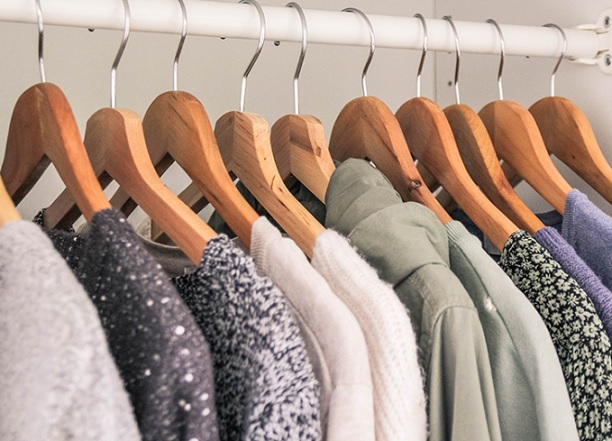GOTS-certified organic cotton, OEKO-TEX-approved recycled polyester, and fabrics with sustainable prospects for end-of-life disposal are a few of the most eco-friendly fibers out there. Bamboo can also be sustainably produced when harvested without pesticides and with water-efficient processing.
LYOcell, made from the pulp of eucalyptus trees, is a new sustainable fabric that’s a more sustainable alternative to viscose. Look for brands that use Lenzing-branded LYOcell, such as Tamga Designs and Girlfriend Collective.
Organic Cotton
Cotton is a natural fiber, but conventional cotton crops are water-intensive and prone to pests when overfarmed. Organic cotton mitigates these issues by avoiding toxic pesticides and fertilizers, using less water (up to 218 billion gallons per year), and using no synthetic irrigation methods.
Look for GOTS-certified organic cotton. This ensures your clothing is 100% organic, and the fabric was made using only organic fibers and environmentally responsible production practices.
Another excellent choice for sustainable textiles is linen, which has many of the same benefits as cotton, but without water waste. It’s also cool, lightweight, antimicrobial, and moth-resistant!
Soy Silk
A fabric with silk-like qualities, soy silk (also known as “vegetable cashmere”) is one of the most environmentally friendly fabrics. This fascinating textile takes soy protein from soybean waste left over from the food industry’s manufacturing process and turns it into a material using minimal processing and chemicals.
Unlike cotton, which requires excessive water and pesticide use, soy silk is a closed-loop fabric, meaning the chemicals used during production can be recycled. The material also uses natural, renewable energy to power the mills that make it.
This makes it an excellent alternative to viscose rayon made from wood pulp which uses harmful chemicals during production.
Linen
Linen is a natural fabric that has been in use for thousands of years. It’s made from flax plants, which require far less water than cotton and do not need any chemicals or pesticides (as long as they are grown in a rotation system to protect the soil). It is also biodegradable.
Look for linen that has been GOTS certified or STeP by OEKO-TEX or is B Corp licensed to ensure it has no harmful dyes in the production process. It’s breathable, calm, and absorbent- perfect for the summer! Linen is often bleached to get a bright color, so stick with natural-toned options. It’s best to avoid any chemical-based dyes, as they can damage the environment.
Hemp
Hemp is a great sustainable fabric as it is naturally biodegradable. When you wear hemp clothes, they become softer and more comfortable with every wash. Hemp also has natural thermoregulating properties and keeps you cool in summer and warm in winter.
Hemp is made from the long strands of the hemp plant’s stem and turned into fiber through the steam explosion. Hemp is one of the most potent natural fibers resistant to mold, mildew, and salt water. It’s incredibly versatile and can be blended with other plant-based fibers to create soft, smooth fabrics. Hemp also drapes beautifully and takes dyes well. Hemp is a sustainable choice for warm-weather wardrobes.
Recycled Polyester
Polyester is a synthetic fabric that has become ubiquitous in our closets. It is durable, stretchy, and affordable to produce. It also resists fungi and moths. It is quick-drying and colorfast.
It can be made in various styles and is versatile enough to suit almost any function. But unfortunately, polyester does not biodegrade and releases microplastics during every wash (more than 27 million plastic water bottles end up in oceans yearly).
Thankfully, an alternative is recycled polyester (also known as rPET). This fabric does not require virgin materials like crude oil and gas. This makes it an environmentally friendly and cheaper option than regular polyester.
Pinatex
A newer fabric that is becoming more popular is only. Made from recycled plastic like industrial waste and fishing nets, it’s closed-loop and an excellent choice for sustainable activewear, with brands such as Outerknown and Girlfriend Collective offering clothing in this material.
It’s also plant-based, free from animal slaughter, and a vegan alternative to animal leather. The leather industry is notoriously damaging to the environment, from large-scale concentrated animal feeding operations to chemical-intensive processes for preparing hides that pollute rivers and lakes.
Pinatex uses pineapple leaf fibers, a byproduct of the existing pineapple fruit industry, and corn-based polylactic acid (PLA). The fabric is soft, lightweight, breathable, and water-resistant.
Tencel
Tencel, also known as lyocell or modal, is made from wood pulp sourced responsibly from Lenzing’s closed-loop production process. Unlike cotton, it doesn’t require bleaching, so it is more environmentally friendly and can be dyed without chemicals.
It’s soft, breathable, and moisture-wicking, meaning you won’t have to wash it as often, which saves water and energy. It also has a natural cooling effect on the skin and is less susceptible to odorous bacteria growth.
It’s also biodegradable and compostable in industrial, home, soil, and marine environments to revert to nature. It’s sometimes blended with synthetic fabrics such as nylon, so check labels to avoid green-washing.







